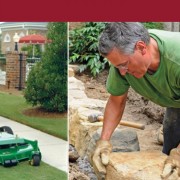Top Safety Tips for Landscapers
Landscape contractors and their employees face increased threats of injuries because of the nature of their work – some as a result of nature itself.
Severe weather, biting insects, sun exposure, and even animals are just some of the hazards that present safety challenges. Add back-breaking work, high-powered equipment use, and chemical applications, and you have a recipe for risk.
Landscape contractors face a number of challenges when it comes to keeping their
employees safe. These challenges may include risks like hot weather, power equipment,
heavy lifting, and repetitive work. Employers should take a proactive approach by
providing proper equipment, pre-season and regular training, and safety talks, especially
for new hires. Some measures that improve safety awareness on job sites include:
General safety
• Instruct employees to report chronic health conditions to their supervisor/employer (allergies, heart problems, asthma, diabetes, etc.).
• Report all incidents, including near misses, immediately to supervisors
• Enforce a zero-tolerance policy for working under the influence of alcohol or drugs.
• Wear protective equipment for job-specific tasks, such as boots, gloves, safety glasses, hearing protection, high visibility vest, head protection, and respirators.
• Be aware of heat exhaustion and take preventive measures for sun protection,
including SPF lotion, water, and protective clothing.
• Follow proper lifting techniques. Bend at the knees, place hands under the
object, and push up with knees to lift. Get help if an object is too heavy.
• Identify dangerous plants, animals, and surroundings, and maintain a safe working distance.
Lawn mower/equipment safety
• Provide training on various equipment per manufacturers’ specifications.
• Fuel and start equipment on level ground. Let equipment cool before refueling – remove the cap slowly and never over-fill the tank.
• To avoid smoke inside a trailer, place the exhaust system facing out.
• Do not operate equipment during severe weather conditions, including windstorms and thunderstorms.
• Walk through the job site prior to mowing to remove stones, bottles, pine cones, sticks, and objects that can create a hazard. Be aware
of standing water.
• Keep hands and feet away from blades and moving parts.
• Never pull a push mower backward or operate a riding mower in reverse. Mow from the bottom to the top of a hill.
• Only use a riding mower on a slope less than 15 degrees. Mow up and down slopes, turning around on level ground.
• Ensure that the motor is off and the spark plug wire is disconnected before changing blades or performing repairs.
• Use two hands to hold equipment, wrapping thumbs and index fingers around the grip.
• Operate weed eaters close to the ground.
Pesticide safety
• Review Material Safety Data Sheets (MSDS), and keep them readily available. Make sure all pesticides are labeled. Follow mixing
instructions and be aware of recommended medical assistance.
• Designate trained employees to handle pesticide applications.
• Do not smoke, drink, or eat while working with pesticides, and know the location of decontamination sites.
• Place pesticides in rear section of truck and make sure containers are secured and in good condition.
• Clean up spills immediately (control, contain, clean).
• Wash hands after working with pesticides, and wash soiled clothing separately from other clothing.



